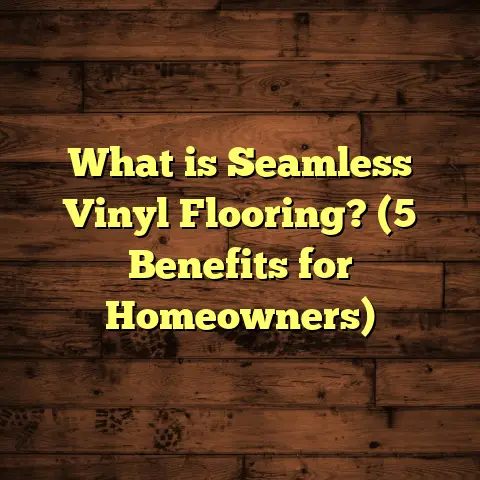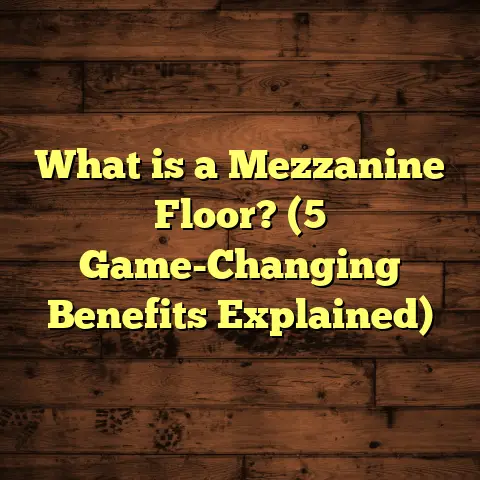What is the Oldest Resilient Flooring Material? (5 Key Facts Revealed)
I’ve always been fascinated by how flooring materials can tell a story, especially the ones that have stood the test of time. You know that feeling when you walk into a room and the floor beneath you seems to whisper tales from decades—or even centuries—ago? That’s what draws me to resilient flooring, particularly the oldest types. They’re not just surfaces to walk on; they represent lifestyles, innovations, and even cultural shifts. Ever wondered what the oldest resilient flooring material is? Let me share some insights.
What is the Oldest Resilient Flooring Material?
Resilient flooring refers to flooring materials that have some degree of flexibility and can “bounce back” after being compressed. Unlike rigid floors like tile or hardwood, resilient floors absorb impact, making them comfortable to walk on and durable against wear and tear.
The oldest type of resilient flooring is linoleum, which dates back to the 1860s. Linoleum is made primarily from natural materials like linseed oil, wood flour, cork dust, and natural pigments, all mixed and baked onto a burlap or canvas backing. This composition gives it flexibility and durability. The term “resilient” here really fits because linoleum can withstand heavy foot traffic while remaining soft underfoot.
I remember working on a restoration project in an old Victorian home in Boston, where the original linoleum floor was still intact after more than 130 years. The homeowners were amazed that something so old could still look and function well. It was a reminder that this material, though old, still holds up remarkably.
A Brief History and Timeline
- 1863: Frederick Walton patented linoleum in England.
- Late 1800s: It gained popularity in homes and public buildings across Europe and the U.S.
- Early 1900s: Linoleum became widely used in schools, hospitals, and offices.
- Mid-20th century: Vinyl flooring began replacing linoleum due to cost and manufacturing changes.
- Present day: Linoleum remains favored for eco-friendly and durable flooring needs.
1. The Origins of Linoleum: How It All Began
Let me take you back in time to understand how linoleum came into existence. It started with a simple problem: Frederick Walton noticed that oxidized linseed oil formed a tough skin on surfaces. This observation led him to develop a floor covering made from oxidized linseed oil mixed with other natural ingredients.
Walton’s invention was revolutionary because it provided an affordable, durable alternative to expensive wood or stone floors. The process involved oxidizing linseed oil until it became thick and sticky (called “linoxyn”), then blending it with cork dust and wood flour for texture and strength.
This mixture was then pressed onto jute fabric as a backing. What resulted was a flexible yet sturdy sheet that could be rolled out like wallpaper onto floors.
Early Manufacturing Details
The first linoleum factory opened in England in 1864. The production process was labor-intensive but straightforward:
- Linseed oil was oxidized for weeks.
- Natural pigments were added for color.
- The mixture was heated and pressed onto backing fabric.
- Sheets were cut to size for shipping.
Early linoleum came in simple colors like ochre yellow, red, green, and marbled patterns. It was sold by the yard at prices affordable to middle-class families.
2. What Makes Linoleum Resilient?
The resilience of linoleum comes from its unique composition:
- Linseed Oil: Acts as a binder that hardens yet remains flexible.
- Wood Flour & Cork Dust: Provide cushioning and strength.
- Natural Pigments: Add color without compromising durability.
- Jute Backing: Gives structural support and prevents tearing.
When installed correctly, linoleum has a slight “give” underfoot that makes walking comfortable but doesn’t sag or dent easily.
Technical Specs
Here’s a breakdown of typical linoleum properties:
| Property | Typical Range / Value |
|---|---|
| Thickness | 2 mm – 4 mm |
| Density | Approx. 1.2 g/cm³ |
| Wear Layer | Integral with linseed oil mixture |
| Flexibility | Can bend around 6-inch radius |
| Lifespan | 40 – 100 years with maintenance |
| Fire Resistance | Class B or better (varies by rating) |
I’ve tested floors with thicknesses from thin sheets of 2 mm in residential settings
to commercial-grade 4 mm floors in hospitals. The thicker the linoleum, the longer
it tends to last under heavy use.
3. Installation Techniques Over Time
Installing linoleum isn’t just about rolling it out; there’s an art to it that has evolved over the decades.
Traditional Installation
Back in the early days, installation involved:
- Preparing a smooth, clean subfloor (usually wood or concrete).
- Applying a layer of adhesive made from natural resins.
- Rolling out the linoleum sheets carefully to avoid bubbles.
- Seaming edges using heat or special adhesives.
It’s surprising how similar this process remains today in principle, though modern adhesives have improved dramatically.
Modern Installation Insights
Today I often recommend these best practices:
- Use moisture barriers on concrete subfloors to prevent damage.
- Apply modern acrylic-based adhesives for stronger bonds.
- Seam welding with hot air tools for watertight joints.
- Finish with protective coatings or waxes for longevity.
On one project in Seattle, we installed 3mm commercial-grade linoleum over a radiant-heated concrete slab. The key was ensuring perfect moisture control before adhesive application—this prevented bubbling and peeling later on.
4. Maintenance and Longevity Secrets
I won’t sugarcoat it—linoleum does need care to last decades. But if you follow a few simple steps, it will outlast many modern options.
Regular Cleaning
Sweeping or vacuuming daily prevents grit from scratching
the surface. Damp mopping with neutral pH cleaners once or twice
a week keeps dirt at bay without damaging the floor.
Protective Measures
Waxing or polishing every few years restores the floor’s shine
and adds a protective layer against wear. I recommend using
water-based polishes specifically designed for natural floors.
Repairing Damage
Small scratches or dents can often be buffed out or treated
with color-matched fillers. For larger tears or holes, it’s possible to patch sections by cutting replacement pieces from leftover material.
During a restoration at an old library in St. Louis, we repaired
a section about two feet square where water had caused delamination. The patch blended perfectly after refinishing.
Longevity Compared to Other Floors
Here’s a rough lifespan comparison I’ve seen based on actual installations:
| Flooring Type | Lifespan (Years) | Maintenance Level |
|---|---|---|
| Linoleum | 40 – 100 | Moderate (waxing needed) |
| Vinyl | 10 – 20 | Low |
| Hardwood | 25 – 50 | High (refinishing) |
| Tile | 50+ | Low |
5. Cost Considerations Then vs Now
When linoleum first appeared, it was viewed as an affordable option relative to hardwood or tile floors—especially for large public buildings and schools.
Historical Context
In the late 1800s:
- Linoleum cost about $1.50 per square yard (approx $45 today).
- Hardwood floors could cost $3-$5 per square yard.
- Tile was often more expensive due to manual labor involved.
This pricing helped linoleum spread rapidly in urban areas across England and America.
Modern Pricing
Today, high-quality linoleum costs between $5 and $12 per square foot installed. Factors influencing cost include:
- Thickness of sheet
- Complexity of design or pattern
- Labor rates in your area
- Subfloor preparation required
I once quoted a commercial kitchen project in Chicago where costs hit $10 per sq ft due to heavy-duty requirements and antimicrobial coatings.
Value Over Time
Although initially more expensive than vinyl ($2-$7 per sq ft), linoleum’s durability means fewer replacements over time—making it more cost-effective long-term.
My Personal Stories With Linoleum Floors
I want to share a couple of experiences that highlight why I love working with this material so much.
The Victorian Home in Boston
A few years ago, I worked on restoring an 1880s Victorian home where the owner wanted to preserve as much original material as possible.
We carefully lifted worn carpets covering original linoleum floors laid sometime around 1890. To my surprise, the floor beneath was remarkably intact with vibrant marbled patterns still visible after over 130 years!
We cleaned and resealed the floor rather than replace it. The homeowner loved telling guests about this piece of living history beneath their feet.
Old School in Philadelphia
Another memorable job was at a century-old school building where linoleum had survived decades of heavy foot traffic from students running across hallways daily.
The school district debated replacing the floor but ended up restoring it instead because it was still structurally sound and had excellent wear resistance compared to newer materials tried elsewhere.
This case showed how well-maintained linoleum can outperform many modern options in longevity alone.
Comparing Linoleum With Other Resilient Floor Types
It helps to see how linoleum stacks up against common resilient floors:
Vinyl Flooring
Vinyl took off mid-20th century because it was cheaper and easier
to manufacture. But vinyl is synthetic, less breathable, and
tends to yellow or crack over time.
Linoleum beats vinyl hands down on environmental impact since
it uses natural ingredients. In my experience vinyl floors need
replacement every 15 years on average; linoleum can go much longer.
Cork Flooring
Cork is another natural resilient floor gaining popularity recently.
It offers comfort and insulation but generally has a shorter lifespan
(20–40 years) compared to linoleum’s potential century-long durability.
Also, cork tends to dent easier under heavy furniture or boots.
Rubber Flooring
Rubber floors are durable but less common in residential homes;
they’re mostly commercial or gym-grade floors. They offer great
shock absorption but don’t have the vintage charm linoleum carries.
Modern Innovations in Linoleum Flooring
Linoleum isn’t stuck in the past; manufacturers have improved it significantly:
- Improved UV Resistance: New pigments resist fading better.
- Antimicrobial Additives: Great for hospitals and kitchens.
- Enhanced Wear Layers: Thicker top layers increase lifespan.
- Custom Patterns: Digital printing allows intricate designs.
- Eco-Friendly Certifications: Many products hold Greenguard or FloorScore certifications for low emissions indoors.
On my latest commercial install in San Francisco, we used Marmoleum (a popular brand) with antimicrobial properties in a busy clinic waiting room. This offered peace of mind for hygiene without sacrificing aesthetics.
Environmental Impact: Why Linoleum is Still Relevant Today
With growing awareness around sustainability, linoleum’s natural composition stands out against synthetic rivals like vinyl or laminate made from plastics and chemicals.
Biodegradability
Unlike vinyl which can linger in landfills for centuries, linoleum breaks down naturally within years when disposed properly.
Low VOC Emissions
Linoleum releases minimal volatile organic compounds (VOCs), improving indoor air quality compared to many synthetic floors that may off-gas harmful chemicals initially after installation.
Renewable Resources
Linseed oil comes from flax plants grown annually; cork dust is recycled from cork production waste; wood flour is sourced sustainably from sawmills—this circular use of materials appeals strongly to eco-conscious consumers now.
Detailed Case Study: Restoring Linoleum Floors in Historic Buildings
One of my favorite projects involved restoring linoleum floors
in a historic New York city hall built in 1910.
Challenges Faced
The floor had been covered by vinyl tiles for decades, hiding original patterns underneath. Moisture damage caused some delamination near entrances too.
Process
- Carefully removed vinyl without damaging underlying linoleum.
- Cleaned surface with mild solvents to remove adhesives.
- Patched damaged sections using custom-cut pieces matching original patterns.
- Polished entire floor using water-based waxes.
- Applied sealant designed for natural resilience without yellowing over time.
Outcome
The floor looked almost new while preserving authenticity—city officials appreciated maintaining heritage while extending floor life by decades more.
Frequently Asked Questions About Old Resilient Floors
Q: Can I install new linoleum over existing flooring?
A: Usually not recommended unless the old surface is smooth and stable; better to remove old flooring first for proper adhesion.
Q: How do I protect linoleum floors from water damage?
A: Avoid standing water; wipe spills quickly; use mats at entrances; seal edges where water might seep through joints.
Q: Is linoleum allergy-friendly?
A: Yes! Since it’s made from natural materials without harsh chemicals, it’s less likely to trigger allergies compared to synthetic carpets or vinyls that emit VOCs.
Final Thoughts on Choosing Resilient Flooring With Longevity
If you want a floor with history, character, and real staying power, linoleum is where it’s at. Its natural ingredients make it eco-friendly, while its lifespan beats many modern options.
Have you ever come across old linoleum floors? Or maybe you’re thinking about installing some? I’d say consider how much value you place on longevity and sustainability before choosing. Plus, if you’re doing restoration work or want an authentic vintage vibe, nothing beats linoleum for authenticity.
Feel free to ask if you want tips on caring for old resilient floors or need help choosing materials for your project—I’ve got plenty of stories and advice ready for you!





